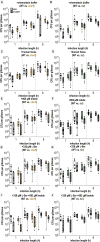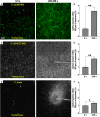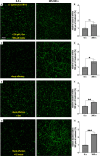Navigating contradictions in enteric chemotactic stimuli
- PMID: 40788306
- PMCID: PMC12339005
- DOI: 10.7554/eLife.106261
Navigating contradictions in enteric chemotactic stimuli
Abstract
Previously, we showed Enterobacteriaceae use chemotaxis and the chemoreceptor Tsr for attraction to blood serum (Glenn et al., 2024). Here, we investigated the complementary role of Tsr in mediating chemorepulsion, a behaviour by which motile bacteria avoid deleterious compounds to locate permissive niches. In the gut, indole is a bacteriostatic compound produced by microbiota and thought to act as a chemorepellent for invading pathogens, thereby protecting the host against infection. The principal reservoir of intestinal indole is fecal matter, a complex biological material that contains both attractant and repellent stimuli. Whether indole in its natural context is sufficient for pathogen chemorepulsion or host protection has remained unknown. Using an intestinal explant system, we show that pure indole suppresses an infection advantage mediated through chemotaxis for the enteric pathogen Salmonella Typhimurium, but this effect is abolished in the presence of other fecal chemoeffectors, including the chemoattractant L-Serine (L-Ser), dependent on the chemoreceptor Tsr. Live imaging reveals that although S. Typhimurium is repelled by pure indole, the pathogen is actually strongly attracted to human fecal matter despite its high indole content, and this response is mediated by Tsr, which simultaneously senses both stimuli. Fecal attraction is conserved across diverse Enterobacteriaceae species that harbor Tsr orthologues, including Escherichia coli, Citrobacter koseri, Enterobacter cloacae, and clinical isolates of non-typhoidal Salmonella. In a defined system of fecal chemoeffectors, L-Ser and other fecal chemoattractants override indole chemorepulsion, but the magnitude of bacterial chemoattraction is controlled by indole levels. Together, these findings suggest chemorepulsion elicited by indole is not protective against enteric infection and actually benefits pathogens by helping them locate niches with lower competitor density. Our study highlights the limitations of applying single-effector studies in predicting bacterial behavior in natural environments, where chemotaxis is shaped by the integration of multiple, often opposing, chemical signals.
Keywords: Citrobacter koseri; E. coli; Enterobacter cloacae; Escherichia coli; Salmonella enterica Typhimurium; infectious disease; microbiology; microbiome; molecular biophysics; structural biology.
© 2025, Franco et al.
Conflict of interest statement
KF, ZG, MS, MH No competing interests declared, AB AB owns Amethyst Antimicrobials, LLC (Pullman, WA)
Figures












Update of
-
Navigating contradictions: Salmonella Typhimurium chemotaxis amidst conflicting stimuli of the intestinal environment.bioRxiv [Preprint]. 2025 May 22:2024.01.18.576330. doi: 10.1101/2024.01.18.576330. bioRxiv. 2025. Update in: Elife. 2025 Aug 11;14:RP106261. doi: 10.7554/eLife.106261. PMID: 38293242 Free PMC article. Updated. Preprint.
References
-
- Bai X, Huang Z, Duraj-Thatte AM, Ebert MP, Zhang F, Burgermeister E, Liu X, Scott BM, Li G, Zuo T. Engineering the gut microbiome. Nature Reviews Bioengineering. 2023;1:665–679. doi: 10.1038/s44222-023-00072-2. - DOI
MeSH terms
Substances
Grants and funding
LinkOut - more resources
Full Text Sources

